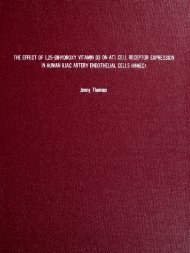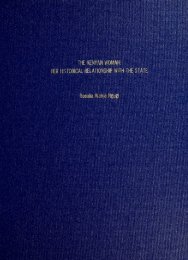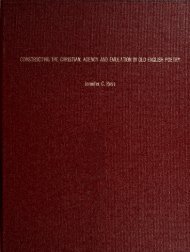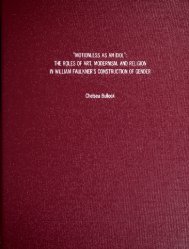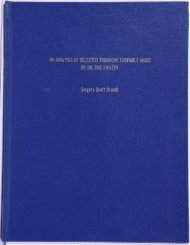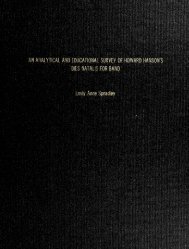An Analytical and Educational Survey of Roger Boutry's Mtachrome
An Analytical and Educational Survey of Roger Boutry's Mtachrome
An Analytical and Educational Survey of Roger Boutry's Mtachrome
You also want an ePaper? Increase the reach of your titles
YUMPU automatically turns print PDFs into web optimized ePapers that Google loves.
images through motives, harmony, <strong>and</strong> exotic scales (whole tone, octatonic, <strong>and</strong> pentatonic) <strong>and</strong>did not focus on resolutions. He treated music as an art <strong>of</strong> sound, particularly through timbre <strong>and</strong>would <strong>of</strong>ten associate particular instruments with motives <strong>and</strong> separated musical layers throughtone color.Although large orchestras are required for many <strong>of</strong> his works, Debussy used soundsfor color, not for volume (Grout, 2006).Erik Satie (1866-1925) is known for his innovations in the use <strong>of</strong> parallel ninths, but it ishis "anti-Debussy mentality ,, that is <strong>of</strong> particular interest (Rost<strong>and</strong>, 1973). He was a strongadvocate for "the unembellished <strong>and</strong> the bare, <strong>and</strong> his search for simplicity <strong>and</strong> systematicnakedness" (Rost<strong>and</strong>, 1973). Satie's importance lies in directing the new generation <strong>of</strong> youngFrench composers away from impressionism towards a more concise style, Neo-classicism(Satie, 2008). This led to the group <strong>of</strong> composers known as Les Six, made up <strong>of</strong> composersGeorges Auric, Louis Durey, Arthur Honegger, Darius Milhaud, Francis Poulenc, <strong>and</strong> GennaineTailleferre, <strong>and</strong> the group was given its name in 1920 by the critic Henri Collet. Les Six wereunited by their anti-Romanticism <strong>and</strong> appreciation for Satie's music, but soon broke <strong>of</strong>f intodifferent paths (Griffiths, 2008). Honneger became a serious minded symphonic composer,Milhaud pursued polytonality, Durey became a committed Socialist, <strong>and</strong> Tailleferre faded awayalmost completely. Poulenc <strong>and</strong> Auric were the only two to maintain loyalty to the group'soriginal st<strong>and</strong> that music should be "spare, witty, <strong>and</strong> up to date" (Griffiths, 2008).The 1930s was a stagnant period for France in regards to innovations in music <strong>and</strong> thearts. Composers during this time include Henri Sauguet, Jacques Ibert, Jean Francais, JeanRivier, <strong>and</strong> Maurice Jaubert. This marked the end <strong>of</strong> the predominance <strong>of</strong> melody <strong>and</strong> solidtonality in French music, <strong>and</strong> after WWII French composers began experimenting <strong>and</strong> looking





